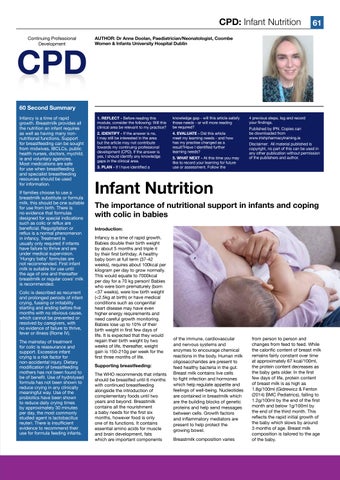CPD: Infant Nutrition Continuing Professional Development
CPD
61
AUTHOR: Dr Anne Doolan, Paediatrician/Neonatologist, Coombe Women & Infants University Hospital Dublin
60 Second Summary Infancy is a time of rapid growth. Breastmilk provides all the nutrition an infant requires as well as having many nonnutritional functions. Support for breastfeeding can be sought from midwives, IBCLCs, public health nurses, doctors, mychild. ie and voluntary agencies. Most medications are safe for use when breastfeeding and specialist breastfeeding resources should be used for information. If families choose to use a breastmilk substitute or formula milk, this should be one suitable for use from birth. There is no evidence that formulas designed for special indications such as colic or reflux are beneficial. Regurgitation or reflux is a normal phenomenon in infancy. Treatment is usually only required if infants have failure to thrive and are under medical supervision. ‘Hungry baby’ formulas are not recommended. First infant milk is suitable for use until the age of one and thereafter breastmilk or regular cows’ milk is recommended. Colic is described as recurrent and prolonged periods of infant crying, fussing or irritability starting and ending before five months with no obvious cause, which cannot be prevented or resolved by caregivers, with no evidence of failure to thrive, fever or illness (Rome IV). The mainstay of treatment for colic is reassurance and support. Excessive infant crying is a risk factor for non-accidental injury. Dietary modification of breastfeeding mothers has not been found to be of benefit. Use of hydrolysed formula has not been shown to reduce crying in any clinically meaningful way. Use of the probiotics have been shown to reduce daily crying times by approximately 30 minutes per day, the most commonly studied agent is lactobacillus reuteri. There is insufficient evidence to recommend their use for formula feeding infants.
1. REFLECT - Before reading this module, consider the following: Will this clinical area be relevant to my practice?
knowledge gap - will this article satisfy those needs - or will more reading be required?
2. IDENTIFY - If the answer is no, I may still be interested in the area but the article may not contribute towards my continuing professional development (CPD). If the answer is yes, I should identify any knowledge gaps in the clinical area.
4. EVALUATE - Did this article meet my learning needs - and how has my practise changed as a result?Have I identified further learning needs?
3. PLAN - If I have identified a
5. WHAT NEXT - At this time you may like to record your learning for future use or assessment. Follow the
4 previous steps, log and record your findings. Published by IPN. Copies can be downloaded from www.irishpharmacytraining.ie Disclaimer: All material published is copyright, no part of this can be used in any other publication without permission of the publishers and author.
Infant Nutrition The importance of nutritional support in infants and coping with colic in babies Introduction: Infancy is a time of rapid growth. Babies double their birth weight by about 5 months and triple it by their first birthday. A healthy baby born at full term (37-42 weeks), requires about 100kcal per kilogram per day to grow normally. This would equate to 7000kcal per day for a 70 kg person! Babies who were born prematurely (born <37 weeks), were low birth weight (<2.5kg at birth) or have medical conditions such as congenital heart disease may have even higher energy requirements and need careful growth monitoring. Babies lose up to 10% of their birth weight in first few days of life. It is expected that they would regain their birth weight by two weeks of life, thereafter, weight gain is 150-210g per week for the first three months of life. Supporting breastfeeding: The WHO recommends that infants should be breastfed until 6 months with continued breastfeeding alongside the introduction of complementary foods until two years and beyond. Breastmilk contains all the nourishment a baby needs for the first six months, however food is only one of its functions. It contains essential amino acids for muscle and brain development, fats which are important components
of the immune, cardiovascular and nervous systems and enzymes to encourage chemical reactions in the body. Human milk oligosaccharides are present to feed healthy bacteria in the gut. Breast milk contains live cells to fight infection and hormones which help regulate appetite and feelings of well-being. Nucleotides are contained in breastmilk which are the building blocks of genetic proteins and help send messages between cells. Growth factors and inflammatory mediators are present to help protect the growing bowel. Breastmilk composition varies
from person to person and changes from feed to feed. While the calorific content of breast milk remains fairly constant over time at approximately 67 kcal/100ml, the protein content decreases as the baby gets older. In the first few days of life, protein content of breast milk is as high as 1.8g/100ml (Gidrewicz & Fenton (2014) BMC Pediatrics), falling to 1.2g/100ml by the end of the first month and below 1g/100ml by the end of the third month. This reflects the rapid initial growth of the baby which slows by around 3 months of age. Breast milk composition is tailored to the age of the baby.





